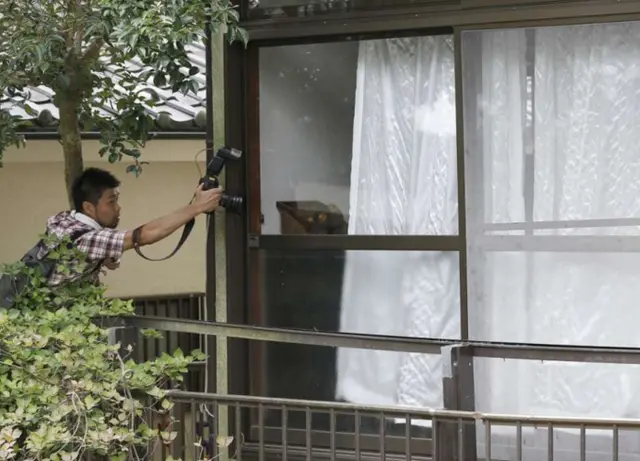The killing of 19 people at a home for the mentally disabled raised questions about whether Japan’s reputation as one of the safest countries in the world is creating a false sense of security.
The deadliest mass killing in Japan since the second world war unfolded early Tuesday in Sagamihara, a city about 50 kilometres west of central Tokyo, when authorities say a former employee broke into the facility and stabbed more than 40 people before calmly turning himself in to police. The suspect, identified as 26-year-old Satoshi Uematsu, had worked at the facility from 2014 until February, when he was let go. He wrote to Parliament outlining the bloody plan and saying all disabled should be put to death.
While not immune to violent crime, Japan has a relatively low homicide rate of well under one per 100,000 people. Mass killings usually are seen half a world away on the nightly news, although seven Japanese were among the dead in a recent hostage-taking in Bangladesh that targeted non-Muslims.
Because such massacres are rare, Japan has become overconfident about its safety, a Japanese criminologist said.
While not immune to violent crime, Japan has a relatively low homicide rate of well under one per 100,000 people. Mass killings usually are seen half a world away on the nightly news, although seven Japanese were among the dead in a recent hostage-taking in Bangladesh that targeted non-Muslims.
Because such massacres are rare, Japan has become overconfident about its safety, a Japanese criminologist said.
“Like in foreign countries, I think institutions need to develop a plan in operational management and prepare for a worst-case scenario, given that criminals are inevitably born.”
Mass killings have happened in Japan from time to time. In 2001, a man with a history of mental illness killed eight children in a knife attack at an elementary school in Osaka. The attack prompted increased security measures for schools. In 2008, a man rammed a rented two-ton truck into a crowd of shoppers at a busy Tokyo intersection, then jumped out and began stabbing people, killing seven.
And, of course, there was the 1995 release of sarin gas by the doomsday cult Aum Shinrikyo in Tokyo’s subway system that killed 13 people and harmed thousands - an attack that stands out because it was committed by a ideologically motivated group rather than an individual.
Homicides are rare, too. Last year, there were 933 homicides in Japan, which has a population of 127.3 million. The toll marked a decline from 1,054 the year before. The United States has more than twice the population of Japan, but FBI statistics for 2014, the most recent year for which data is available, show 11,961 homicides - more than 11 times the number in Japan that year.
In China there were 10,083 homicide cases in 2014, according to the latest official data from the National Bureau of Statistics of China.
When the United Nations Office on Drugs and Crime (UNODC) issued a report on global homicide in 2014, it singled out Japan’s low rate as notable.
“With no notable fluctuations, the homicide rate in Japan has decreased steadily since 1955 to reach one of the lowest levels in the world,” the report’s authors noted.
“The country’s homicide rate is associated with a stable and prosperous society with low inequality and high levels of development.”
The UNODC cited a number of theories for why homicides occurred so rarely in Japan, including the fact that 98 per cent of homicide cases are solved, the growth of affluence and a general rejection of violence after the second world war - even the country’s organised criminals, the yakuza, are said to avoid violent confrontations, coming up with unusual techniques such as standing outside a business swinging a cat by its tail to extort money.
hen there is the scarcity of guns in Japan. The country has strict requirements for owning a gun and harsh punishments for those who break the rules. As a consequence, there are few guns in the country; Japan has 0.6 guns per 100 civilians compared with 101 guns per 100 civilians in the United States, and even firearm enthusiasts seem comfortable with that. Japan had a single shooting death in 2015, compared with more than 13,000 in the United States. According to one count, 475 people were killed in mass shootings alone in the United States last year.
The rampage in Sagamihara does show that even without guns, attacks with a high number of fatalities can happen.
TV news regularly reports on murders — a jilted lover, an adult son angry at his parents — and the most common weapon is a kitchen knife.
A Justice Ministry study in 2013 found that knives were used in slightly more than half the murder cases in a given year, with kitchen knives accounting for more than a third of all cases.
National Police Agency statistics show there have been fewer than 10 shooting deaths annually in Japan in recent years, a number that dropped to just one case in 2015.
The comfort level is high enough in Japan that it is common practice for first-grade students to go to and from school on their own, after parents accompany them for the first month or so, even in a major city such as Tokyo. Children are kidnapped from time to time.
Another factor contributing to Japan’s sense of safety, Komiya said, is the fact that the island country has never been invaded.
In the immediate aftermath of Tuesdays attack, Google search results showed a spike in searches for “Japan ISIS” as international users apparently sought to square the violence with a global trend.
Ultimately, the care-facility attack seems to be driven by more localised and personal problems.
(AP)
 简体中文
简体中文

